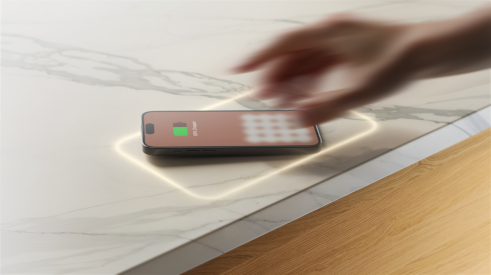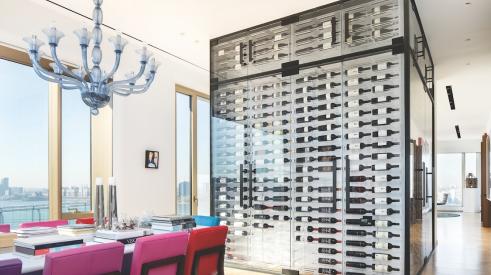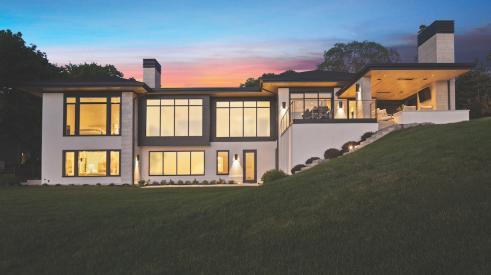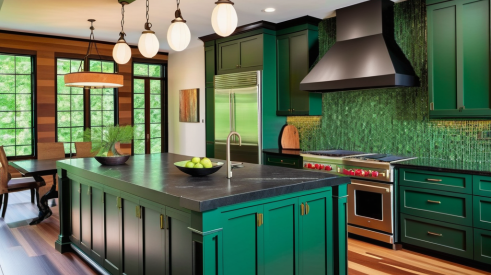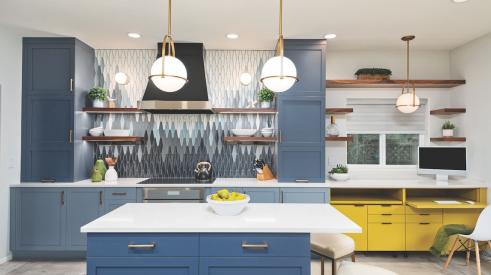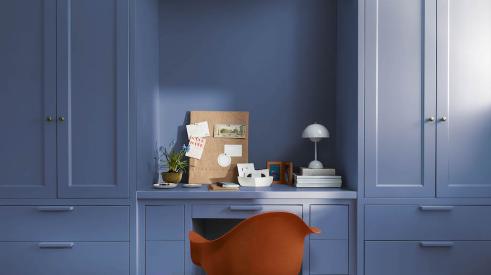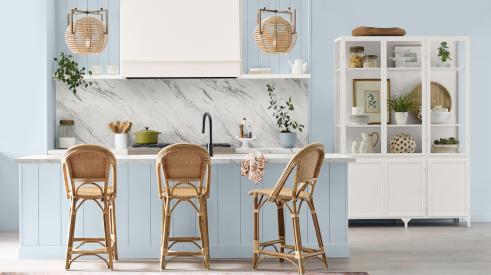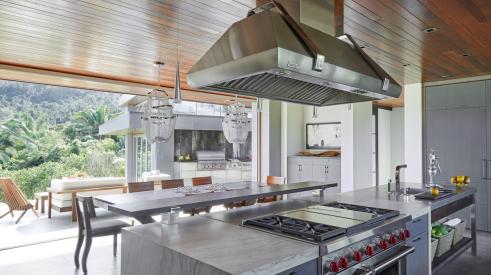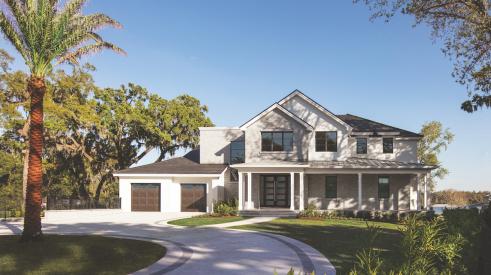A few years ago, the Carmaria Condo Association hired Landis Construction to spruce up the exterior of their 1901 row house in Washington, D.C., repointing the brickwork, replacing windows, painting. While Landis was there, three of the four condo owners planned to contract individually with the Washington, D.C., design/build company for kitchen remodels.
The Carmaria building is far superior today than it was before Landis came on board, but except for an updated entry the façade is largely untouched. What happened? This is the story of a building emergency, a dramatic regrouping, structural surgery, and, in the thick of it all, a shining example of low-cost, high-style kitchen renovation.
Shocker
The building is located in the Columbia Heights, an area, says third-floor condo owner Mike Holland, that “bore the brunt of the 1968 riots” that broke out following the assassination of Martin Luther King. Many structures were looted and burned. Soon after the riots the
Carmaria was converted to apartments, with one unit on each of four floors, including the basement. In the late 1990s a developer bought the building, made cosmetic improvements, flipped it, and sold it as condominiums.
In 2005 the owners began noticing problems with their kitchens, which are stacked at the middle of the building. “My refrigerator door was catching on the floor,” says Holland. The floors felt “squishy.” Holland’s counters had separated about ¼-inch from the wall; his upstairs neighbor’s kitchen counters had separated an inch from the wall. “We thought the problem was just with the kitchens,” says Holland.
The Carmaria condo association asked three contractors for estimates on the exterior and kitchen work. “We had two structural engineer reports,” says Holland, and Landis conducted in-wall probes, all of which identified some structural deterioration but nothing major. “We thought we might have to cut out the column of kitchens, install new joists, and build new kitchens.”
Meat of the building
How wrong they were. As Landis began demolition on the kitchen column, says Holland, “We discovered that rot extended through the back three quarters of the building.”
Landis project manager Andrew Kerr asserts, “This was the single best example of neglect and fraudulent construction I’ve ever seen.”
Turns out that a 1990s fire that gutted the building next door had spread to the Carmaria, destroying the roof. For a decade, the Carmaria sat vacant and exposed to the elements. Landis found that some 70 percent of the L-shaped structure was a pile of rot, broken roof beams, fire damage, and termite destruction. The developer had simply covered the damage under a new roof and sold the building to unsuspecting condo owners. “He totally scammed us,” says Holland.
“Floor joists showed as much as 10 inches of deflection,” says Kerr.
When condo association members met with him in one of their unremodeled kitchens, he asked them to step back from areas of floor unstability.
“Not a single thing in the building had been done legally or to code. This was one of the most dangerous work sites I’ve ever seen,” Kerr says. (For various reasons, suing the developer was not a realistic option.)
The condo association had assembled around $400,000 to replace the kitchen column and update the exterior. They now faced “significantly more work than budgeted,” says Kerr, to the tune of an extra $200,000.
Landis “was very understanding about what we could afford,” says Holland. “They told us, ‘We will figure out how to triage’ the situation” to make the building right as affordably as possible, Holland says. Kerr explains, “We recommended that most of the aesthetic changes on the outside get scrapped” for the time being, so that the enhanced budget could be redirected toward “redoing the entire meat of the building.”
Over the next three months, Landis performed reconstructive surgery, gutting the back of the building down to the basement and installing new framing, walls, roofing, flooring, plumbing, air conditioning, wiring, the works.
Sizzling kitchen
Even before the structural problems were uncovered, the condo owners had allocated a lot of money to the remodeling project, leaving little for their own unit updates. Holland says the reconstruction “stretched everybody’s budget nearly to the breaking point.”
Holland hoped to transform his drab, poorly planned kitchen and living area into a space with style, function, and flair.
“It had to be done dirt cheap,” he says. Through inspired design and aggressive economizing, Landis delivered a glittering, one-of-a-kind kitchen and living zone for less than $33,000. Holland paid only about $17,500 directly; the remaining $14,000 — for general infrastructure improvements in the kitchen — came out of condo association funds.
T
he original 75-square-foot plan wasted space and included only one kitchen drawer. The refrigerator door, when open, blocked access to the stove. Landis rearranged the floor plan, absorbing an adjacent closet to gain space and extending the kitchen into the dining/living area, visually expanding both areas by linking them. The re-thought space is “fantastically functional, like night and day,” says Holland.
A scientist, Holland requested two lab-style finishes in the kitchen: green cabinet doors and soapstone counters. Dark soapstone counters wrap around the room.
Landis found cabinets and doors at IKEA in two commanding looks — black and green glass — for a bargain price. In the time between when Landis designed the kitchen and Holland was ready to order the cabinets, though, the green doors were discontinued.
Landis design manager Greg Gardner quickly launched a nationwide search, tracking down enough doors for Holland’s kitchen still in stock at a store in Washington state. (Though IKEA sells primarily to consumers looking for low-priced items, Gardner has used IKEA cabinets in several projects. “I think they make a good product,” he says. “The cabinets have good contemporary design flair. Their internal hardware is superior to some lower-end cabinet products on the market that are more expensive.” The only inefficiency, he says, is that parts have to be ordered and picked up at the store.)
Walnut finish bookshelves in the living room gave Landis the idea to incorporate matching walnut accents in the kitchen. A local craftsman built a simple, round walnut table that perches at the junction between kitchen and living area, providing seating and counter area for both. (Walnut trims the new fireplace mantel and chimney chase too.)
Kerr built a curved wall around the table, angle cutting the studs and bending wet drywall against a round form. Mechanicals hide behind this wall.
Green glass mosaic tiles on the curved wall complement the green doors. While dramatically stylish, the tile is a relatively low-budget feature.
“We used the cheapest glass tile we could find,” says Holland. “I found the red pendant light online for $114,” he adds.
One potentially tricky issue — venting the range hood in a condo building — actually was made easier by the building reconstruction. Instead of snaking ductwork through the existing wall, Kerr installed a full mechanical chase when building the new wall.
Five months after the mass of building problems was discovered, the Carmaria building was sound again and Holland’s kitchen remodel was complete. Ironically, the building façade changed so little — gaining a new front door, little else — that a passerby would never imagine the trauma that had taken place out back or the wonderful transformation inside.
Structural disaster and inspired renovation hide behind a vintage façade
Add new comment
Related Stories
This New Tech Turns Any Countertop into a Wireless Charger
FreePower for Countertop has swept awards for its innovation—and the company claims installing it is "as straightforward as cutting a sink"
Designing, Building, and Installing a Luxury Custom Wine Cube
An 11-foot wine cube enveloping a pantry is the stand out feature of this customized New York penthouse
Marvin Releases Switchable Privacy Glass Window
The privacy glass windows can be purchased from Marvin's Direct Glaze windows
Building A Small Projects Division from the Ground Up
Through hard work and careful strategy, Harth Home Services has seen big growth
Client Design Choices in the Time of Social Media and AI
Social media speeds up the trend cycles, and now artificially created images are falling into homeowners' hands
Design Trends to Watch in 2024
What’s in and out for the upcoming year? Remodeling designers share insights
Insights for Designing Outdoor Kitchens
Was the pandemic-fueled thirst for outdoor kitchen remodels and additions a fluke, or is it here to stay? Plus: The top design considerations for outdoor kitchens
Home Run Remodeling Lessons: The New American Remodel 2023
A final look at The New American Remodel 2023




